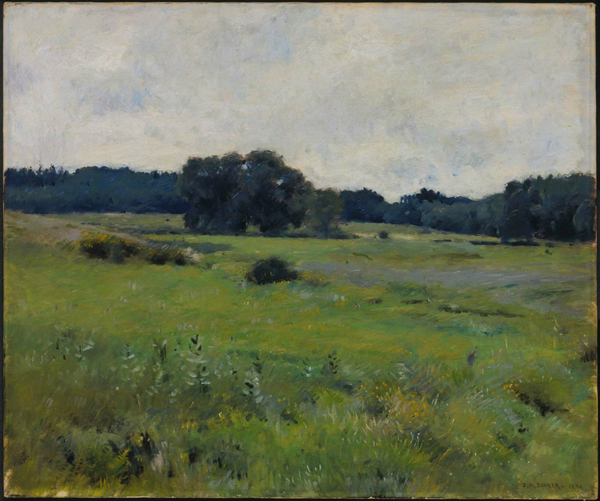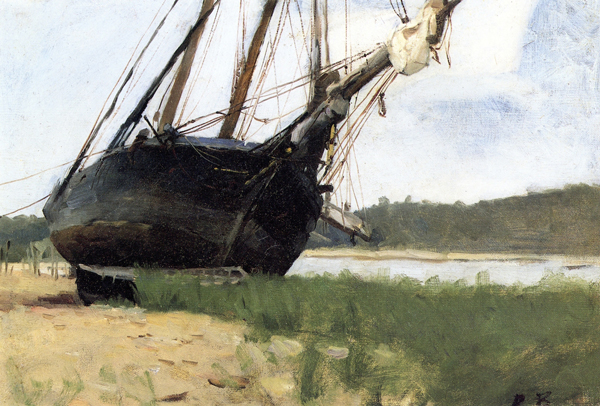
Dennis Miller Bunker. Meadow Lands (1890).
Dennis Miller Bunker is considered to be one of the greatest American painters. He died tragically young, at age 29, in 1890. He studied with Jean Léon Gérôme at the Ecole des Beaux Arts in Paris, was one of the first ‘American Impressionists’, and he painted with John Singer Sargent.
One of his best students was William Paxton, who taught R. H. Ives Gammell (who taught my teacher, Charles Cecil). Gammell wrote a biography on Bunker, published in 1953, and in the book there are a number of personal letters given to him by Bunker’s widow. I reread the biography earlier this year, and the following letter from Bunker to his then-fiancée struck me as being particularly insightful into the working life of the artist:
You must try to realize how dull and monotonous an artist’s life is. There is absolutely nothing but work, work, work. And there is nothing in the work of an artist that shows his personality. You are marrying a man whose highest ambition is to conceal his identity, to remain above his work and apart from it, not to appear in it in any way – to be as cold and calm as a machine. Oh! if I only could, I might some day learn to paint! What I am trying to tell you is not to nourish any any ideas of an artist people whom you see may expound to you. Don’t think, as they do, that the charm of an artist’s work must be found also in his own personality. It is always apart, or should be, should have nothing to do with it, and that is what makes it such an infernal trade. Never to play on ones’s own twopenny flute but to keep the big end in view always; to remain patient and cold and quiet and work like a dog from morning ’til night; there is no other way of arriving even at talent, unless one is cut out of larger stuff than I am.

Dennis Miller Bunker. Tree (1884).
That’s it really. That’s all I wanted to say. Since you took the time to get here though, I’ll leave you with this passage from the book as well. In it Gammell beautifully express the idea of breadth and detail in painting:
People untrained in the art of painting often believe that finish is attained by simply adding detail to detail and consequently they dismiss it as a mere by product of industry and patience. Unfortunately this view does not correspond with the truth. For an essential characteristic of all fine painting is unity of effect and this unity is destroyed by any detail stated in a false relation to the other component parts of the picture. This is particularly true of the type of painting we are here discussing, the purpose of which is to recreate on canvas the impression made on the painters’s eye by the landscape before him. To achieve this end, each detail must be set down with just the degree of definition and coloration which it holds for the eye when the focus of vision is adjusted so as to include the entire scene depicted. Piecemeal notation of individual detail immediately destroys the requisite unity of impression and turns the canvas into a compilation of separately observed visual facts. This invariably results in a hard, dry look, destroying all breadth of effect and offensive to those who are quite unaware of its technical cause. It is, in fact, one of the most serious defects which a painting can have and perhaps the most difficult defect for an earnest painter to avoid. The ability to carry a picture to a high degree of finish without losing its unity of impression is the mark of a master and requires artistry of the highest order. It is the central problem of the type of painting which takes for its main theme the interpretation of the beauty of the visible world.

Dennis Miller Bunker. Beached (1882).
For those of you noticing the wide range of style in the posted images of Bunker’s landscapes, Darren Rousar has an interesting post on Bunker’s move from the more Academic influence of Gerome, to the Impressionism of his later style.

Great post, Marc. Thanks.
This is a wonderful discourse, and reveals so much of the conflicting states of the artist and his pursuit of any greatness in his art.
Marc next to your art always appreciate your insightful thoughts and references on art. Thanks
What a great post, yes.
And I almost feel hopeless when I see such great work at such a young age.
These are beautiful! I’d never seen them. Thanks for posting, along with these great quotations. HH
Thanks, sir for all your areas of work and thoughts..
An article like this one can give to a painter like me, who doubts, the energy to restart.
I enjoyed the comments about “Detail” in an artist work.For some reasons its remined me of an article writen by russian master painter Sergei Bongart.I’d like to shere this article as its very informative and beautifully written. Bingart was a great painter and a great teacher. He thought in Santa Monica.
http://www.nasonart.com/writing/bongartlessons.html
Marc, thanks for sharing, a new artist to me and I have already printed out the quotes
Nice to see these quotes. I studied with Gammel the last year in Williamstown, Ma. the summer before he died, 1980. I remember it well, as short a time it was.
Inspiring work. Thank you for sharing it.
Thanks Marc,
Meadow Lands, I love this painting. The few dark bits in the foreground make this painting.
A previous comment by Jim Gersin on this post captured my first thoughts: “Marc next to your art [I] always appreciate your insightful thoughts and references on art.”
We readers and viewers of your web site are fortunate to have you showing the way, in so many ways. Thanks for sharing this resource from your library.
And following your lead, I now realize where I have seen Bunker’s name before [and Bunker himself]. As you know…until now I didn’t… he’s the subject of Sargent’s 1888 painting “Dennis Miller Bunker Painting at Calcot”. You’ve shown us at least one example of his work before, but this post has prompted me to give Bunker some more research time. Many thanks.
Thank you Marc. Your heart and guidance are ever appreciated.